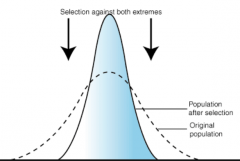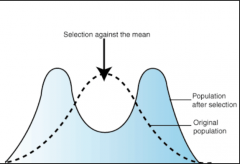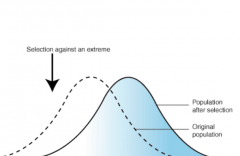![]()
![]()
![]()
Use LEFT and RIGHT arrow keys to navigate between flashcards;
Use UP and DOWN arrow keys to flip the card;
H to show hint;
A reads text to speech;
44 Cards in this Set
- Front
- Back
|
Evolution |
Accumulation of inherited changes in populations over time, leading to related species
|
|
|
Darwinian Fitness |
An individual's ability to survive and reproduce relative to other members of a population |
|
|
Population |
Group of individuals of one species living in one geographic area and sharing the same gene pool |
|
|
Species |
Group of populations composed of organisms with common ancestry, sharing similar structures, functions, behaviours, etc. and able to freely interbreed in nature |
|
|
Community |
Group of species that live together and interact in a given area |
|
|
Ecosystem |
An interactive system composed of one or more communities and their abiotic (physical) environment |
|
|
Biosphere |
All of earth's ecosystems taken together |
|
|
Theory of Evolution by Natural Selection |
1. Variation in phenotype exists among individuals 2. High reproductive potential means populations increase geometrically 3. Individuals compete for limited resources 4. 'Fit' offspring with phenotypes matching current environment more likely to reproduce |
|
|
Evidence Supporting Evolution |
|
|
|
Evidence for Evolution from Fossils and Geology |
|
|
|
Artificial Selection |
Start with starting population with some variation in phenotype, take extreme phenotype and use seed for next year |
|
|
Homologous Features |
Derive same structure in common ancestor (look different in adult, similar in embryo) |
|
|
Homoplastic Features |
Similar functions in distantly or unrelated organisms result in convergent evolution (look similar but no common origin)
|
|
|
Vestigial Structures |
Remnants of structures indicate adaptations wax and wane as environments change |
|
|
Convergent Evolution |
Unrelated but display structural and/or functional similarities |
|
|
Phylogeny |
Evolutionary history of a group of related species displayed as phylogenetic trees
|
|
|
Developmental Homology |
Species that differ as adults often bear similarities as embryos |
|
|
Adaptations |
Evolved characteristics enhancing an organism's survival or reproduction in a particular environment |
|
|
Proximate Explanation |
An immediate, mechanistic explanation not requiring evolutionary thinking |
|
|
Ultimate Explanation |
A more fundamental, historical explanation involving an evolutionary perspective |
|
|
Locus |
Plysical location on chromosome (we have to loci for each gene because we have 2 chromosomes) |
|
|
Gene Pool |
Includes all the alleles for all the loci present in the population
|
|
|
Genotype |
The combination of alleles at a given locus, on homologous chromosomes |
|
|
What is genetic variation in populations caused by? |
|
|
|
Balanced Polymorphism |
Situation in which two different versions of a gene are maintained in a population of organisms because individuals carrying both versions are better able to survive (heterozygote advantage) |
|
|
Frequency Dependant Selection |
Fitness of a phenotype depends on its frequency relative to other phenotypes in a given population |
|
|
Phenotypic Plasticity |
One genotype can produce different phenotypes in different environments |
|
|
Ecotype |
Partly differentiated but not enough to be a new species |
|
|
Norm of Reaction |
Continuous range of phenotypic possibilities (plasticity) for a genotype under different environmental conditions
|
|
|
Morphological Traits |
Show quantitative genetic variation = multiple loci + environmental effects |
|
|
Causes of microevolution (changes in allele frequency) |
|
|
|
Hardy-Weinberg Principle |
Provides a 'Null Hypothesis' for what happens to gene frequencies between generations in the absence of evolution
|
|
|
Hardy-Weinberg Equations |
1. p+q=1 (p=frequency of dominant allele, q=frequency of recessive allele)
2. p²+2pq+q²=1 (freq. of homozygous dominant genotype + freq. of heterozygous genotype + freq. of homozygous recessive genotype = 1) |
|
|
Nonrandom Mating |
1. Inbreeding (selfing or matings b/t close relatives, can produce inbreeding depression) 2. Assortative mating common in animals (tall prefers tall)
Both eventually decrease frequency of heterozygous genotypes |
|
|
Genetic Drift |
Random changes of allele frequencies in small populations, often due to 'sampling'
|
|
|
Bottleneck |
A sudden decrease in population size due to environmental factors such as drought |
|
|
Founder Effect |
Genetic drift occurring when a small population colonizes a new area |
|
|
Gene Flow |
Movement of alleles by migration of individuals or gametes between populations
|
|
|
Natural Selection |
Causes changes in phenotype frequencies, increasing those best adapted now
|
|
|
What are the three modes of selection on continuous (polygenic) traits? |
|
|
|
Stabilizing Selection |

Favours the mean or 'typical' individual
|
|
|
Disruptive Selection |

Favours two or more phenotypic extremes at expense of individual near the mean |
|
|
Directional Selection |

Favours one phenotypic extreme |
|
|
Sexual Selection |
When there is competition for mates among makes (intrasexual) or when females are choosey about mates (intersexual), sexual selection may favour traits which increase male mating success |

